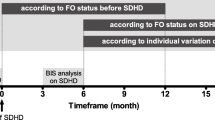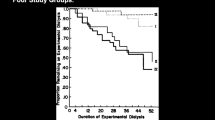Abstract
Objective
Several studies have reported a close relationship between an increased dose of dialysis and survival in patients treated for acute renal failure. Unfortunately, the quantification of dialysis in critically ill patients based on the urea nitrogen formula Kt/V is not applicable. Ionic dialysance is a new parameter calculated in real time from the dialysate conductivity and correlated with the effective urea clearance in chronic hemodialysis patients. The aim of our study was to evaluate ionic dialysance in the quantification of dialysis in critically ill patients with acute renal failure.
Design
Prospective open-label study.
Setting
An 18-bed medical intensive care unit.
Patients
Thirty-one patients with multiple organ dysfunction syndrome and acute renal failure requiring intermittenthemodialysis were included.
Measurements
Using the first dialysis session of each patient, we compared the delivered dose of dialysis based on ionic dialysance measurement (KtID) with the well-accepted gold standard method based on fractional dialysate sampling (Ktdialysate). The data were analyzed using linear regression and Bland–Altman analysis.
Results
Thirty-one intermittent hemodialysis sessions were performed in 31 critically ill patients (mean age 58 ± 12 years, SAPS II score 56 ± 10). We found a close correlation between Ktdialysate and KtID (Ktdialysate = 36.3 ± 11.4 l; KtID = 38.4 ± 11.8; r = 0.96) with excellent limits of agreement (–2.2 l; 6.4 l).
Conclusion
The feasibility of dialysis quantification based on ionic dialysance in the critically ill patient is good. This method is a simple and accurate tool for the determination of dialysis dose in critically ill patients.



Similar content being viewed by others
References
Guerin C, Girard R, Selli JM, Perdrix JP, Ayzac L (2000) Initial versus delayed acute renal failure in the intensive care unit. A multicenter prospective epidemiological study. Rhone-Alpes Area Study Group on Acute Renal Failure. Am J Respir Crit Care Med 161:872–879
Metnitz PG, Krenn CG, Stelzer H, Lang T, Ploder J, Lenz K, et al (2002) Effect of acute renal failure requiring renal replacement therapy on outcome in critically ill patients. Crit Care Med 30:2051–2058
De Mendonça A, Vincent JL, Suter PM, Moreno R, Dearden NM, Antonelli M, Takala J, Sprung C, Cantraine F (2000) Acute renal failure in the ICU: risk factors and outcome evaluated by the SOFA score. Intensive Care Med 26:915–921
Guérin C, Girard R, Selli JM, Ayzac L (2002) Intermittent versus continuous renal replacement therapy for acute renal failure in intensive care units: results from a multicenter prospective epidemiological survey. Intensive Care Med 28:1411–1418
Ronco C, Bellomo R, Homel P, Brendolan A, Dan M, Piccinni P, La Greca G (2000) Effects of different doses in continuous veno-venous haemofiltration on outcomes of acute renal failure: a prospective randomised trial. Lancet 356:26–30
Schiffl H, Lang SM, Fischer R (2002) Daily hemodialysis and the outcome of acute renal failure. N Engl J Med 346:305–310
Clark WR, Mueller BA, Kraus MA, Macias WL (1998) Renal replacement therapy quantification in acute renal failure. Nephrol Dial Transplant 13(Suppl 6):86–90
Gotch FA, Sargent JA, Keen ML (2000) Whither goest Kt/V? Kidney Int Suppl 76:S3–18
Evanson JA, Ikizler TA, Wingard R, Knights S, Shyr Y, Schulman G, Himmelfarb J, Hakim RM (1999) Measurement of the delivery of dialysis in acute renal failure. Kidney Int 55:1501–1508
Marshall MR, Golper TA, Shaver MJ, Alam MG, Chatoth DK (2002) Urea kinetics during sustained low-efficiency dialysis in critically ill patients requiring renal replacement therapy. Am J Kidney Dis 39:556–570
Li Z, Lew NL, Lazarus JM, Lowrie EG (2000) Comparing the urea reduction ratio and the urea product as outcome-based measures of hemodialysis dose. Am J Kidney Dis 35:598–605
Lowrie EG, Chertow GM, Lew NL, Lazarus JM, Owen WF (1999) The urea [clearance × dialysis time] product (Kt) as an outcome-based measure of hemodialysis dose. Kidney Int 56:729–737
Cheng YL, Shek CC, Wong FK, Choi KS, Chau KF, Ing TS, Li CS (1998) Determination of the solute removal index for urea by using a partial spent dialysate collection method. Am J Kidney Dis 31:986–990
Lindsay RM, Bene B, Goux N, Heidenheim AP, Landgren C, Sternby J (2001) Relationship between effective ionic dialysance and in vivo urea clearance during hemodialysis. Am J Kidney Dis 38:565–574
Mercadal L, Petitclerc T, Jaudon MC, Bene B, Goux N, Jacobs C (1998) Is ionic dialysance a valid parameter for quantification of dialysis efficiency? Artif Organs 22:1005–1009
Mercadal L, Du Montcel ST, Jaudon MC, Hamani A, Izzedine H, Deray G, Bene B, Petitclerc T (2002) Ionic dialysance vs. urea clearance in the absence of cardiopulmonary recirculation. Nephrol Dial Transplant 17:106–111
Le Gall JR, Klar J, Lemeshow S, Saulnier F, Alberti C, Artigas A, Teres D (1996) The Logistic Organ Dysfunction system. A new way to assess organ dysfunction in the intensive care unit. ICU Scoring Group. JAMA: 276:802–810
Schortgen F, Soubrier N, Delclaux C, Thuong M, Girou E, Brun-Buisson C, Lemaire F, Brochard L (2000) Hemodynamic tolerance of intermittent hemodialysis in critically ill patients: usefulness of practice guidelines. Am J Respir Crit Care Med 162:197–202
National Kidney Foundation (1997) NKF-DOQI clinical practice guidelines for hemodialysis adequacy. Am J Kidney Dis 30:S15–66
Mactier RA, Madi AM, Allam BF (1997) Comparison of high-efficiency and standard haemodialysis providing equal urea clearances by partial and total dialysate quantification. Nephrol Dial Transplant 12:1182–1186
Mercadal L, Ridel C, Petitclerc T (2005) Ionic dialysance: principle and review of its clinical relevance for quantification of hemodialysis efficiency. Hemodial Int 9:111–119
Bland JM, Altman DJ (1986) Regression analysis. Lancet 1:908–909
Kuhlmann U, Goldau R, Samadi N, Graf T, Gross M, Orlandani G, Lange H (2001) Accurancy and safety of online clearance monitoring based on conductivity variation. Nephrol Dial Transplant 16:1053–1058
Ikizler TA, Sezer MT, Flakoll PJ, Hariachar S, Kanagasundaram NS, Gritter N, Knights S, Shyr Y, Paganini E, Hakim RM, Himmelfarb J. PICARD Study Group (2004) Urea space and total body water measurements by stable isotopes in patients with acute renal failure. Kidney Int 65:725–732
Himmerfarb J, Evanson J, Hakim RM, Freedman S, Shyr Y, Ikizler TA (2002) Urea volume of distribution exceeds total body water in patients with acute renal failure. Kidney Int 61:317–323
Lowrie EG, Li Z, Ofsthun NJ, Lazarus JM (2006) Evaluating a new method to judge dialysis treatment using online measurements of ionic clearance. Kidney Int 70:211–217
Evanson JA, Himmelfarb J, Wingard R, Knights S, Shyr Y, Schulman G, Ikizler TA, Hakim RM (1998) Prescribed versus delivered dialysis in acute renal failure patients. Am J Kidney Dis 32:731–738
Vanholder R, De Smet R, Griet G, Argiles A, Baurmeister U, Brunet P, Clark W, Cohen G, De Heyn PP, Deppisch R, Descamps-Latcha B, Henle T, Jorres A, Dieter Lemke H, Massy ZA, Passlick-Deetjen J, Rodrigez M, Stegmayr B, Stenvinkel P, Tetta C, Wanner C, Zidek W (2003) Review on uremic toxins: classification, concentration, and interindividual variability. Kidney Int 63:1934–1943
Acknowledgements
We thank E. Rondeau for his advice during the writing of the manuscript and are grateful to the nursing teams.
Author information
Authors and Affiliations
Corresponding author
Rights and permissions
About this article
Cite this article
Ridel, C., Osman, D., Mercadal, L. et al. Ionic dialysance: a new valid parameter for quantification of dialysis efficiency in acute renal failure?. Intensive Care Med 33, 460–465 (2007). https://doi.org/10.1007/s00134-006-0514-x
Received:
Accepted:
Published:
Issue Date:
DOI: https://doi.org/10.1007/s00134-006-0514-x




